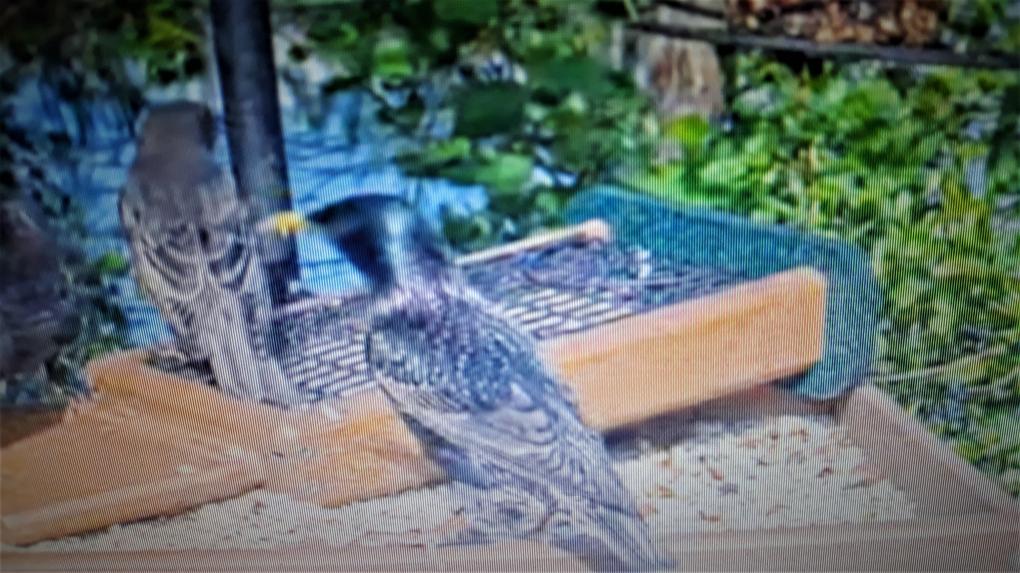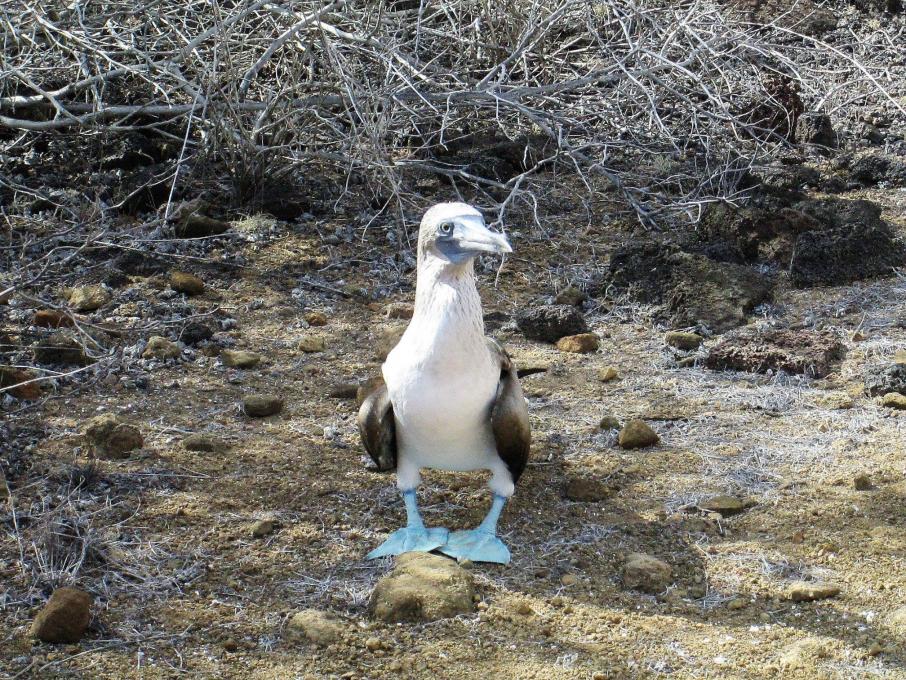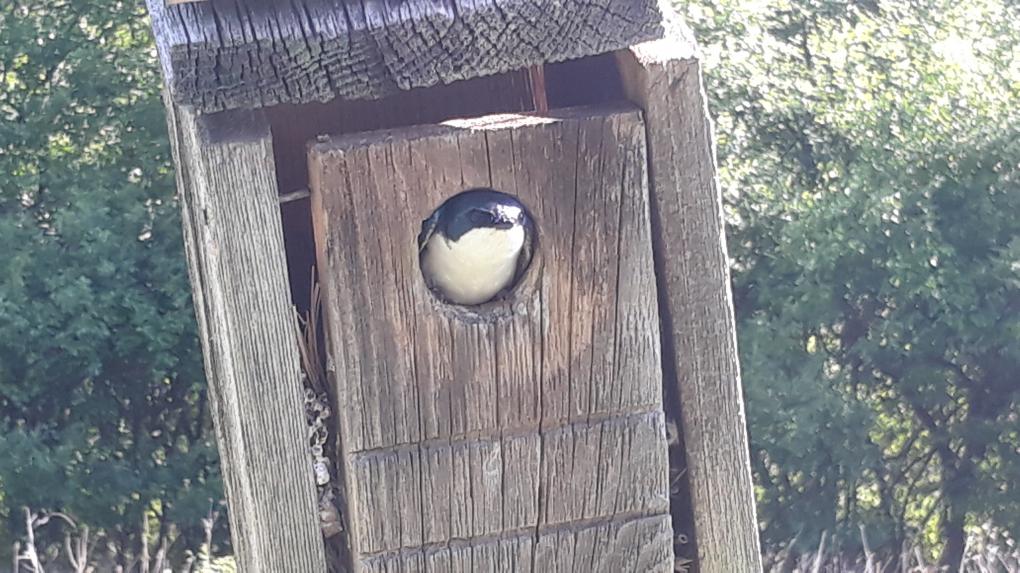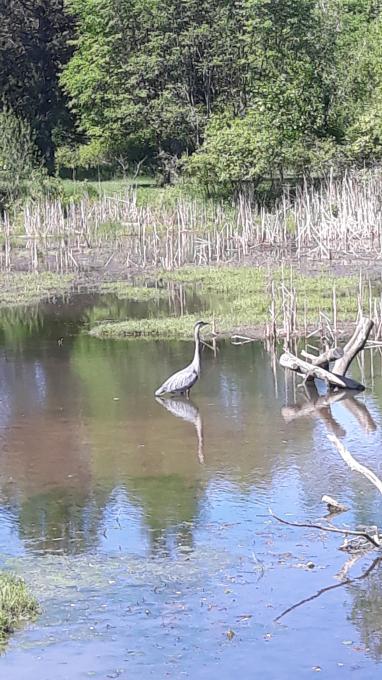Margaret
Forum Replies Created
Viewing 13 posts - 1 through 13 (of 13 total)
-
MargaretParticipantActivity 4. I will be taking small steps to continue and maybe intensify bird-watching, both through some personal effort and through the local Audubon chapter. I have been taking almost daily morning nature/bird-watching walks very locally, focusing on what I can see easily; heron-watching has continued to be attractive. After receiving information from the local Audubon chapter, a friend and I did locate a nesting osprey sitting on the backstop of a high school baseball diamond (near the cell tower where it is nesting) and were able to watch it in flight. I need help making progress on bird sound—very difficult for me to move beyond the really common and easy-to-identify songs and calls. I am also interested in bird behavior and bird science generally and will explore the Cornell university-level beginning ornithology course and will continue reading. I was interested in Eva Meijer’s book, Animal Languages, and what she says about birds, and I am thinking about reading some of Jennifer Ackerman. Any recommendations? I am a social scientist with a focus on human well-being and public policies, but as I have just retired from full-time teaching and research I am making a small pivot towards ecology and the natural environment, and it seems birds may be my entry point.in reply to: Activities: Helping Birds in Your World #714741
-
MargaretParticipantActivity 2. We try hard to limit or eliminate plastics. While some retailers have moved in a better direction, many still automatically dispense lots of plastic bags, and it requires alertness and intention to avoid these. We avoid all pesticides in our yard and vegetable garden. We have tried to plant bird-friendly plants within the limits of our small yard and poor soil. We have maintained an overgrown cherry tree that at least one arborist has suggested we remove. We have planted Bee Balm, Butterfly Weed, and other native flowering plants, and our landscaper says that the grasses he planted in the front yard are bird-friendly in that birds use these grasses to build nests. We could do better here, with Milkweed (we are a monarch-friendly street), Yarrow (abundant in several naturalized areas nearby), Coneflower and Black-eyed Susan, all of which grow in yards on our street. We buy annuals, Calibrachoa, that are hummingbird-friendly. I hope to become more informed and active in bird protection through the local Audubon chapter and Natural Areas Preservation unit of the city. Public policy-- at national, regional, state and local levels-- matters.in reply to: Activities: Helping Birds in Your World #714738
-
MargaretParticipantActivity 2. The Washtenaw Audubon Society offers lots of opportunities for bird watching and bird learning to people at all levels of knowledge, skill and physical ability. Washtenaw County is in southeast Michigan and includes the cities of Ann Arbor and Ypsilanti, as well as less developed and natural areas. The Huron River runs through the county. I have been hovering the edges of the chapter and just officially joined. I went on a group walk last Spring, and in-person group events are mainly cancelled for now. However, the group conducted a prothonotary paddle (separate kayaks) recently, and the trip produced wonderful photos and an amazing short video of a prothonotary warbler singing on the tree where it nested. The chapter has been hosting online presentations (with extraordinary photographs) by a long-time member who now lives (at least part of the year) in Central Florida and knows the birds of Central and South Florida. It will host chimney swift count nights August 14, 15, and 16 at dusk. It has been fighting to preserve a chimney that has become a roosting site and migration staging site for swifts; open stack chimneys are attached to old buildings that are now being destroyed (“urban renewal”), and local Audubon has preserved one chimney at risk of destruction. It organizes bird counts. The chapter maintains close ties to the Natural Areas Preservation unit of the City of Ann Arbor, which does a variety of plant and animal inventories and ecological projects (e.g. turtle stewardship, invasive plant removal), relying heavily on volunteers. And local Audubon pays attention to relevant national policy issues and has supported black birders.in reply to: Activities: Keeping Track of Your Birdwatching #714725
-
MargaretParticipantActivity 2. The two British sites, Down House and Sevenoaks, host species or subspecies different from their North American counterparts and appear to be different collections of habitats. At Down House, the 44 total species include birds that frequent a variety of land habitats, including humanly built and humanly frequented ones –gardens, open fields, and young woodland. For example, the three types of pigeons/doves tend to live in farms and fields, and the corvids and raptors are adaptable generalists. The ring-necked pheasant likes grassland and cropland. The woodpeckers favor woodlands. The Eurasian nuthatch likes deciduous or mixed woodland. The Common Chiffchaff is a warbler that favors wooded and scrubby habitats. (The gulls seemed to be passing overhead). EBird lists 3 rose-ringed parakeets there, I always thought of the parakeet as a cage bird in Europe and North America, but I gather there are wild populations now, probably escaped from city cages. The Sevenoaks birds, 135 total species/sub-species, inhabit either a water-based or land-based habitat, including deep and shallow lakes, ponds, rivers and riverbed, grassland (scrub) and woodland. The water birds include swimming birds (a great variety of ducks, swans, geese) and long-legged waders and other shorebirds (herons and egrets, a Eurasian Spoonbill, Eurasian Oystercatcher, Pied Avocet, Eurasian Curlew, plovers, snipes, sandpipers, gulls). Kingfishers need water, but I’m not sure into what category of bird they fall. The trees and scrub support woodpeckers, warblers (some live in reeds), swallows, cuckoos and swifts. There are also corvids and raptors (Common Buzzard, Red Kite, Eurasian Sparrowhawk, Carrion Crow) with some overlap with Down House species.in reply to: Activities: Exploring Bird Habitats #714252
-
MargaretParticipantActivities 1 and 2 merged, with some other lesson-based observations. We have many House Sparrows near and in our yard, and they participate in a dawn chorus around 4:30 or 5 am (first light) in June. It is difficult to detect where in structures they are nesting. They perch in nearby trees and dense bushes or brush. They are regulars at our feeders, eating mainly smaller seeds (not striped sunflower) and millet, many at the feeding area about the same time, though arrival is staggered and alternating. They also eat on the ground. One neighbor seems to throw out stale white bread, which the birds occasionally have in their beaks as they hop around on the ground. Sparrows also seem to be one of the local urban birds (along with starlings, blue jays and robins) that eat from our overgrown cherry tree. Multiple sparrows at our feeders seem fairly cooperative, with the sparrows either physically spacing themselves out around a flat feeder or perching in turn on the tube feeder rail. They stay longer at the flat feeder than on the tube. They are easily startled. In colder months I’ve seen them pecking at the climbing roses branches, assuming they were taking in the moisture from morning moisture or other, but now I wonder if they were gleaning. On nearby wires when two are in proximity there is a fair amount of tail twitching. They also seem to fluff their feathers a little bit; this is a whole-body movement not just a tail twitch. They preen.in reply to: Activities: Noticing Behaviors #714042
-
MargaretParticipantCardinal and Warbler The Northern Cardinal appears to have considerable range abundance overlap between its breeding and non-breeding seasons and through the year. It does not seem to migrate. The eBird abundance animation shows considerable stability, with some changes in western regions of the U.S. They are present in abundance throughout the year in southeast Michigan. The Blackburnian Warbler, on the other hand, seems to be a long-distance migratory bird. During its breeding season, June 7-July 27, the population seems concentrated in lower eastern Canada and the upper Atlantic states. During its non-breeding season (Nov. 16-March 8) it is abundantly present in the NW region of South America. This warbler spends winter in South America in open forests, including coffee plantations, according to the Cornell Lab. In its pre- and post- breeding migratory seasons it’s present in the U.S. Midwest and East and Central America. Birdwatchers have occasionally said they may have seen one during the migratory season in a wooded area in Ann Arbor. The Tanagers The Scarlet Tanager breeds June 7-August 17 in North America, mainly in the northern eastern quadrant of the U.S. A friend and I saw one –stunning--a couple of times in County Farm Park, Ann Arbor, last summer. During its relatively short December to January non-breeding season it is abundant in northwest regions of South America. Pre- and post-migration it is present in both its breeding and non-breeding areas, Central America, and some additional areas. The Cornell Lab explains the long-distance migration as follows: Long-distance migrant. Twice a year, Scarlet Tanagers fly across the Gulf of Mexico between their breeding grounds in eastern North America and their wintering grounds in South America. They usually migrate at night. Individuals that spend the winter farther south migrate to breeding grounds later, and in more synchronized bursts, than individuals wintering further north. The Western Tanager sticks to the western region of the U.S. and of Mexico and Central America, not reaching as far south as the Scarlet Tanager but migrating farther north into upper Canada. It has a short breeding season, shorter than that of the Scarlet. Ruby-throated Hummingbird and Rufous Hummingbird During its breeding season, June 7- July 27, the Ruby-throated Hummingbird covers the eastern and midwestern U.S. and lower eastern Canada. The morning of June 11 I think one visited our potted Calibrachoe annuals (orange and purple ones) in Ann Arbor, Michigan; it did not have a bright red throat so was a female; is it possible it was a stray female Rufous? In its non-breeding season, the Ruby-throated Hummingbird is abundant mainly in Central America (and on the lower east coast of the Florida peninsula. Their migratory path seems similar in both directions. They thus seem to be tiny birds that migrate long distances from the eastern U.S. to Central America, with peak migration in September (darker yellow on seasons timeline bar). Cornell Lab says they can fly 2,000 km without a break and that older birds travel ahead of younger ones. The Rufous Hummingbird is somewhat similar in its migratory pattern. However, unlike the Ruby-throated Hummingbird, it is present near the west coast of North America and has a slightly earlier and shorter breeding season (May 24-June 14). It also appears to take different migratory paths northward (pre-breeding) and southward (post-breeding). This is a loop migration. The Rufous travels north up the Pacific Coast but returns to the south through Rocky Mountain states--Utah, Wyoming, Colorado, Arizona, New Mexico-- appearing to rely upon mountain meadows for food during southbound migration. Sandhill Crane and Yellow-bellied Flycatcher The Sandhill Crane species in the Western Hemisphere seems to have variations in its migratory behavior. Some smaller sub-species appear to be non-migratory (Cuban, Mississippian, Floridian). The maps on eBird show the population overall migrating northward as early as January and south beginning in August. The breeding population, between May 31 and September 7th, a long breeding season, seems to be very widespread as far north as Alaska and upper Canada. In general, they seem to spend the winter in the southern U.S. and northern Mexico. Migration density pre- and post-breeding seems greatest in Nebraska, Kansas and Oklahoma, a relatively narrow established route. The Platte River in Oklahoma is apparently a massive staging ground for the northward migration. In Southeast Michigan, cranes appear in early March in open fields and meadows. In late September they visit Michigan staging areas (and one friend's backyard in western Washtenaw County) prior to migration to Florida. The small Yellow-bellied Flycatcher is a long-distance migrant. It breeds in New England and eastern Canada, with some populations as far north as lower Alaska and the Canadian Yukon. Unlike the Sandhill Crane, it seems to have a very short breeding season, June 28 to July 13, and each migration season is considerably longer than the short breeding season. The non-breeding season is November through mid-April. The Flycatcher winters in Central America. The Sandhill Crane’s breeding season is May 31- September 7, and each migratory season is about the same length as its breeding season. The migratory path/territory of this flycatcher is also broad, while that of the Sandhill Crane is narrower and concentrated in the central U.S. In both places, its breeding and non-breeding areas, it seems to seek forests or at least shade.in reply to: Activities: Different Seasons, Different Birds #713359
-
MargaretParticipantActivity 3. Using range maps or bar charts, find five birds that pass through your area that you didn’t know about. You can look on eBird, in field guides, on All About Birds, or use Merlin. Using these tools I investigated birds that I had never seen and are hard to spot because of where they alight or fly and because they are present but uncommon. I was unaware that the Indigo Bunting was present in this area. The male is very blue when breeding, and the nonbreeding male is more speckled blue. Females are brown overall with whitish throats and a bluish tail. This bird seems to have a thick conical beak, darker gray on top and whitish on the bottom. Juliet Berger, our outstanding local ornithologist, has posted a spectrogram, but I find most calls hard to identify and remember. The Yellow Throated Vireo also appears in some of the natural wooded areas in the county according to hotspot checklists on EBird and Merlin. It is sparrow-sized and has a bright yellow head and eye ring (bright yellow spectacles), a white underside and white wingbars on black wings, with a thick bill that looks grayish blue from photos. It often favors tall trees near water. The Red-Eyed Vireo is similarly shaped but differently color patterned. Most of the photos show a dark or gray cap, a white streak above the eye, and a dark line through the eye. The back is yellowish (some descriptions say olive green). While some descriptions say there are no wing bars (patches), the photos show wings that are streaked with light yellow. Advanced birders say the red eyed vireo has a very recognizable song, a broken series of slurred notes ending in either a downslur or upswing, as well as well as a recognizable call. The vireos forage in deciduous canopies, probably difficult to spot. According to both EBird and Merlin, Chimney Swifts are present in the local area in summer and fall. Birders refer to this swift as a “flying cigar” because of its body shape. It has long, sickle-shaped wings. The bill is very short and hard to see, and the Chimney Swift has a very short tail. Its plumage is dark gray-brown. It flies continuously with constant wingbeats (no glide) during the day and nests and roosts in chimneys. It eats insects. (I spotted some high-flying, continuously flapping dark birds in a small group yesterday evening; the flight pattern and bird shape were something I had never seen before, and I couldn't identify them.)in reply to: Activities: Local Bird Exploration #712844
-
MargaretParticipant4. A favorite bird, perhaps partly because we can see it easily in this season in southeast Michigan, is the Tree Swallow. It has an extensive summer range in North America but migrates south for the winter. The Tree Swallow seems to be mainly an aerial forager, and it flies (with a glide) over meadows and fields to catch insects. It has very distinctive color markings, including a blue iridescent back and a clean white front and a black mask around its eyes. This bird (a male) is atop a nesting box at about 9 am, June 7, at Matthaei Botanical Gardens (University of Michigan).
 in reply to: Activities: Bird ID Practice #711770
in reply to: Activities: Bird ID Practice #711770 -
MargaretParticipantI have been wrestling with the differences among these dark/black birds, too, especially the distinction between the Starling and Grackle. From what I can see a Grackle has a tapered gray bill, fairly long legs, and a long black tail, with a bright yellow eye. Its feathers are dark blue in the neck and head region, and its feathers are iridescent—blue and bronzy. The European Starling has a long yellow bill, speckled brown feathers, a brown tail shorter than that of a grackle, reddish legs shorter than that of a grackle, and a duller eye. (Male) Red-winged Blackbirds, very common here in southeast Michigan near bodies of water, are black, with red shoulder patches with a yellow line and a medium-sized grayish bill. I think I found a Grackle and a Starling at the Sapsucker Woods feeder. Corrections welcome.

 in reply to: Activities: Bird ID Practice #711197
in reply to: Activities: Bird ID Practice #711197 -
MargaretParticipantFrom a trip to the Galapagos (and on the bird wall) I am fond of the Blue-footed Booby, a sea bird. They are really beautiful and easy to get fairly close to on the islands as there are no predators. I understand they engage in biparental parenting.

 in reply to: Activities: Exploring Birds #710272
in reply to: Activities: Exploring Birds #710272 -
MargaretParticipantTree swallows. . . In at least two public parks (here in
 southeast Michigan) it seems as though naturalists have erected nesting boxes that were intended for bluebirds but seem to be occupied by tree swallows. in reply to: Activities: Exploring Birds #710262
southeast Michigan) it seems as though naturalists have erected nesting boxes that were intended for bluebirds but seem to be occupied by tree swallows. in reply to: Activities: Exploring Birds #710262 -
MargaretParticipant
@Aaron I agree that looks more like a Brown Booby than a Frigate Bird. On a trip to the Galapagos, we saw lots of black frigate birds with those long mainly black wings. We saw beautiful blue-footed boobies mainly on land in mating season.
in reply to: Activities: Exploring Birds #710249 -
MargaretParticipantClose to the Huron River in Michigan, we see Great Blue Herons, mainly in Spring, Summer and Fall. This past Sunday one was wading in a small body of water at Matthaei Botanical Gardens, one of the natural areas curated by the University of Michigan in Ann Arbor.
 in reply to: Activities: Exploring Birds #710244
in reply to: Activities: Exploring Birds #710244
Viewing 13 posts - 1 through 13 (of 13 total)





 southeast Michigan) it seems as though naturalists have erected nesting boxes that were intended for bluebirds but seem to be occupied by tree swallows.
southeast Michigan) it seems as though naturalists have erected nesting boxes that were intended for bluebirds but seem to be occupied by tree swallows. 